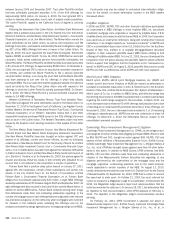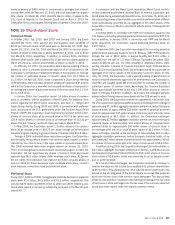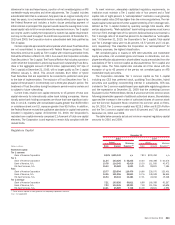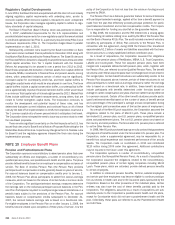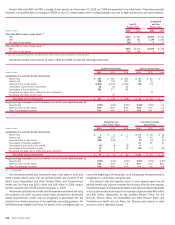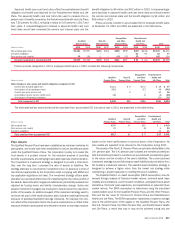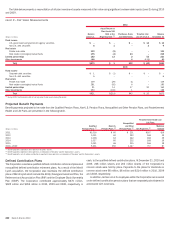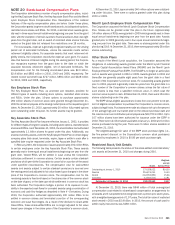Bank of America 2010 Annual Report Download - page 216
Download and view the complete annual report
Please find page 216 of the 2010 Bank of America annual report below. You can navigate through the pages in the report by either clicking on the pages listed below, or by using the keyword search tool below to find specific information within the annual report.Regulatory Capital Developments
In June 2004, the Basel II Accord was published with the intent of more closely
aligning regulatory capital requirements with underlying risks, similar to
economic capital. While economic capital is measured to cover unexpected
losses, the Corporation also manages regulatory capital to adhere to regu-
latory standards of capital adequacy.
The Basel II Final Rule (Basel II Rules), which was published on Decem-
ber 7, 2007, established requirements for the U.S. implementation and
provided detailed requirements for a new regulatory capital framework related
to credit and operational risk (Pillar 1), supervisory requirements (Pillar 2) and
disclosure requirements (Pillar 3). The Corporation began Basel II parallel
implementation on April 1, 2010.
Subsequently, amended rules issued by the Basel Committee on Bank
Supervision known as Basel III were published in December 2010 along with
final Market Risk Rules issued by the Federal Reserve. The Basel III rules and
the Financial Reform Act seek to disqualify trust preferred securities and other
hybrid capital securities from Tier 1 capital treatment with the Financial
Reform Act proposing it to be phased in over a period from 2013 to 2015.
Basel III also proposes the deduction of certain assets from capital (deferred
tax assets, MSRs, investments in financial firms and pension assets, among
others, within prescribed limitations certain of which may be significant),
increased capital for counterparty credit risk, and three capital buffers to
strengthen capital levels which would be also phased in over time. The three
capital buffers include a capital conservation buffer, a countercyclical buffer
and a systematically important financial institution buffer, which would result
in a minimum Total capital ratio of at least eight percent by 2013. Market Risk
Rules include additional VaR based measurements, among others, that are
meant to further strengthen capital levels. The Corporation continues to
monitor the development and potential impact of these rules, and has
determined that given current initiatives and continued focus on all of these
rules by the date of full implementation in 2018, the Corporation must have a
Tier 1 common capital ratio of seven percent which it anticipates it will meet.
The Corporation does not expect the need to issue any common stock to meet
the new Basel proposals.
There remains significant uncertainty on the final impacts as the U.S. has
issued final rules only for Basel II and a Notice of Proposed Rulemaking for the
Market Risk Rules at this time. Impacts may change as the U.S. finalizes rules
for Basel III and the regulatory agencies interpret the final rules during the
implementation process.
NOTE 19 Employee Benefit Plans
Pension and Postretirement Plans
The Corporation sponsors noncontributory trusteed pension plans that cover
substantially all officers and employees, a number of noncontributory non-
qualified pension plans, and postretirement health and life plans. The plans
provide defined benefits based on an employee’s compensation and years of
service. The Bank of America Pension Plan (the Pension Plan) provides
participants with compensation credits, generally based on years of service.
For account balances based on compensation credits prior to January 1,
2008, the Pension Plan allows participants to select from various earnings
measures, which are based on the returns of certain funds or common stock
of the Corporation. The participant-selected earnings measures determine
the earnings rate on the individual participant account balances in the Pen-
sion Plan. Participants may elect to modify earnings measure allocations on a
periodic basis subject to the provisions of the Pension Plan. For account
balances based on compensation credits subsequent to December 31,
2007, the account balance earnings rate is based on a benchmark rate.
For eligible employees in the Pension Plan on or after January 1, 2008, the
benefits become vested upon completion of three years of service. It is the
policy of the Corporation to fund not less than the minimum funding amount
required by ERISA.
The Pension Plan has a balance guarantee feature for account balances
with participant-selected earnings, applied at the time a benefit payment is
made from the plan that effectively provides principal protection for partic-
ipant balances transferred and certain compensation credits. The Corpora-
tion is responsible for funding any shortfall on the guarantee feature.
In May 2008, the Corporation and the IRS entered into a closing agree-
ment resolving all matters relating to an audit by the IRS of the Pension Plan
and the Bank of America 401(k) Plan. The audit included a review of voluntary
transfers by participants of 401(k) Plan accounts to the Pension Plan. In
connection with the agreement, during 2009 the Pension Plan transferred
approximately $1.2 billion of assets and liabilities associated with the trans-
ferred accounts to a newly established defined contribution plan.
As a result of acquisitions, the Corporation assumed the obligations
related to the pension plans of FleetBoston, MBNA, U.S. Trust Corporation,
LaSalle and Countrywide. These five acquired pension plans have been
merged into a separate defined benefit pension plan, which, together with
the Pension Plan, are referred to as the Qualified Pension Plans. The benefit
structures under these acquired plans have not changed and remain intact in
the merged plan. Certain benefit structures are substantially similar to the
Pension Plan discussed above; however, certain of these structures do not
allow participants to select various earnings measures; rather the earnings
rate is based on a benchmark rate. In addition, these benefit structures
include participants with benefits determined under formulas based on
average or career compensation and years of service rather than by reference
to a pension account. Certain of the other benefit structures provide partic-
ipant’s retirement benefits based on the number of years of benefit service
and a percentage of the participant’s average annual compensation during
the five highest paid consecutive years of the last ten years of employment.
As a result of the Merrill Lynch acquisition, the Corporation assumed the
obligations related to the plans of Merrill Lynch. These plans include a
terminated U.S. pension plan, non-U.S. pension plans, nonqualified pension
plans and postretirement plans. The non-U.S. pension plans vary based on
the country and local practices. The terminated U.S. pension plan is referred
to as the Other Pension Plan.
In 1988, Merrill Lynch purchased a group annuity contract that guarantees
the payment of benefits vested under the terminated U.S. pension plan. The
Corporation, under a supplemental agreement, may be responsible for, or
benefit from actual experience and investment performance of the annuity
assets. The Corporation made no contribution in 2010 and contributed
$120 million during 2009 under this agreement. Additional contributions
may be required in the future under this agreement.
The Corporation sponsors a number of noncontributory, nonqualified
pension plans (the Nonqualified Pension Plans). As a result of acquisitions,
the Corporation assumed the obligations related to the noncontributory,
nonqualified pension plans of certain legacy companies including Merrill
Lynch. These plans, which are unfunded, provide defined pension benefits
to certain employees.
In addition to retirement pension benefits, full-time, salaried employees
and certain part-time employees may become eligible to continue participa-
tion as retirees in health care and/or life insurance plans sponsored by the
Corporation. Based on the other provisions of the individual plans, certain
retirees may also have the cost of these benefits partially paid by the
Corporation. The obligations assumed as a result of acquisitions are sub-
stantially similar to the Corporation’s postretirement health and life plans,
except for Countrywide which did not have a postretirement health and life
plan. Collectively, these plans are referred to as the Postretirement Health
and Life Plans.
214 Bank of America 2010




